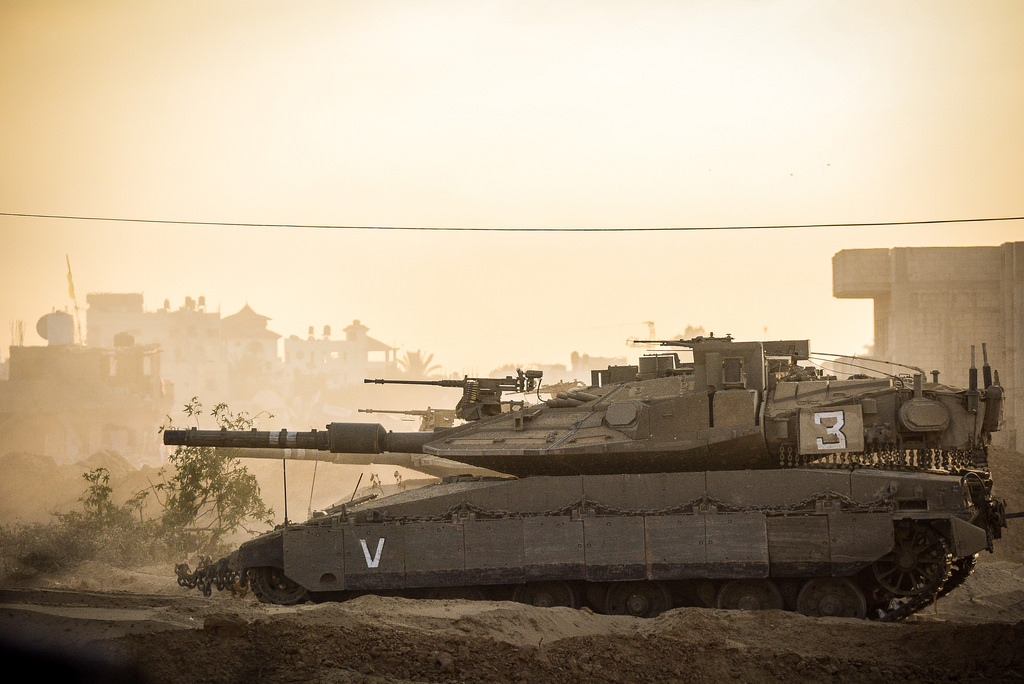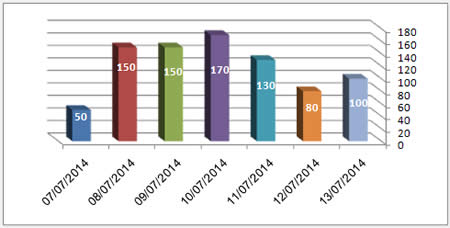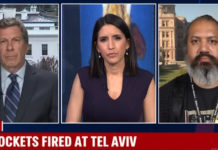Overview of the Situation
Updated to the Seventh Day of Operation Protective Edge
1. The past 24 hours of Operation Protective Edge followed the pattern of the previous days: the IDF continued its intensive attacks on terrorist targets in the Gaza Strip, while Hamas and the other terrorist organizations continued firing massive barrages of rockets and mortar shells into Israel (including targeting central Israel and Haifa in the north). Currently there is also sporadic rocket fire from Lebanon as well as mortar shell fire from the Syrian border with the northern Golan Heights. Appeals for a ceasefire have not significantly advanced.
IDF Activity
Attacks on Terrorist Targets in the Gaza Strip
2. During the past 24 hours the IDF has continued attacking terrorist targets in the Gaza Strip. So far a total of 1,472 terrorist targets have been attacked. Among them were 632 rocket launchers, 130 military-terrorist camps and posts, 97 senior terrorist operatives and more than 220 terrorist tunnels. Two examples of attacks are the following (IDF Spokesman, July 14, 2014):
1) On the afternoon of July 13, 2014, Israeli Air Force (IAF) aircraft attacked two rocket launchers used to fire rockets at the southern cities of Ashdod and Beersheba. A rocket launcher in the northern Gaza Strip was also attacked.
2) Around noon on July 13, 2014, the IDF attacked the terrorist facilityof a senior Hamas operative responsible for rocket fire from the region of the Jabaliya refugee camp. The operational facilityof the commander of the Palestinian Islamic Jihad’s (PIJ) Beit Lahia rocket unit was also attacked.
The Gaza Strip Population
3. The Palestinian media and ministry of health report that 171 Gazans have been killed since the beginning of the operation, and more than 1,100 have been wounded. According to ITIC (initial) information, the distribution of those killed is as follows:
1) 57 terrorist operatives:
a) 29 Hamas operatives
b) 22 PIJ operatives
c) Six operatives from other terrorist organizations
2) 76 non-involved Palestinians
3) 38 Palestinians whose identity still cannot be ascertained.
4. Mufeed Al-Hassayna, Palestinian minister of public works and housing, provided the following data: 292 buildings have been completely destroyed, 283 buildings are not fit for human habitation, and 10,000 buildings have been partially damaged. In addition, he said, there is damage to charity institutions, governmental institutions and the infrastructure (Al-ayyam.com, July 13, 2014).
Harm Done to Palestinian Police
5. Ayman al-Batiniji, spokesman for the Palestinian police department, held a press conference in front of the Al-Shifaa’ hospital. He said that marking policemen and police headquarters as targets for attack was a crime and a violation of international law, and claimed Israel was responsible for the harm done to them (Website of the ministry of the interior in the Gaza Strip, July 13, 2014). Note: In Operation Pillar of Defense and on other occasions it was proved that in emergency situations the security services in the Gaza Strip, which are subordinate to the ministry of the interior, function as part of Hamas’ military-terrorist wing. Many security service operatives are concurrently operatives in the Izz al-Din al-Qassam Brigades.[1]
IDF Appeals to Local Gazan Population to Leave Operational Areas
6. Following the IDF’s distribution of leaflets instructing the residents of the northern Gaza Strip to leave the area, thousands of Palestinians went to the UNRWA schools in Gaza City. The director of the schools said that UNRWA had opened eight schools to house residents of the northern Gaza Strip. He added that more schools would be opened if necessary (Maannews.net, July 13, 2014).
7. After the IDF had distributed the leaflets, Hamas military-terrorist wing issued a notice warning the residents not to leave their houses. According to the notice, leaving would make the resident himself responsible. The ministry of the interior said that Israel’s written and telephone announcements asking Palestinians to leave were meant “to confuse and frighten the public.” According to the notice, the ministry of the interior was responsible for sending notices and instructions to the populace and did so through the media. Compliance with appeals of the [Israeli] “occupation” helped it to carry out its plots, weaken the [Palestinian] home front and destroy the houses and property of those who had left. The ministry also called on those who had vacated their houses to return to them immediately and act in accordance with instructions from the ministry (Website of the ministry of the interior in the Gaza Strip, July 13, 2014). And in fact, a large percentage of the public complied with the ministry’s instructions and remained in their houses despite the IDF attacks on terrorist targets in their neighborhoods.
[The notice distributed by Hamas’ military-terrorist wing: “[This notice is sent to you] out of concern for your welfare. Stay in your house throughout the escalation and do not leave it. Vacating the house makes you fully responsible [for the consequences]. Signed, the Izz al-Din al-Qassam Brigades, July 9, 2014” (Facebook page of the Izz al-Din al-Qassam Brigades, July 13, 2014).
8. The IDF Spokesman said that the Gazans were asked to leave an area from which an increasing number of rockets were being fired into Israel. Therefore, the IDF had decided to make it the focus of massive attacks, and asked the local residents to leave so that uninvolved civilians would not be harmed (IDF Spokesman, July 13, 2014).
International Activists Declare Themselves Human Shields
9. Basman al-Ashi, director of the Al-Wafaa’ Hospital in eastern Gaza City, reported that eight foreign activists from the United States, Venezuela, France, Britain, Sweden and Spain had volunteered themselves human shields. He said they were protecting the hospital so that it could continue to provide its services (Aa.com.tr, July 12, 2014).
Rocket Fire
10. During the past week massive, unabated rocket fire has continued to attack Israel from the Gaza Strip, although it has lessened to a certain extent during the past few days. So far, during Operation Protective Edge 830 rocket hits have been identified in Israeli territory. On July 13, 2014, a 16 year-old boy was critically wounded by rocket fire in Ashqelon. According to the IDF Spokesman, approximately 36% of the rocket launches have originated in the northern Gaza Strip. Of the long-range rockets launched into Israel, approximately 30% have come from the northern Gaza Strip, 10% from Beit Lahia (IDF Spokesman, July 13, 2014).
11. During the past 24 hours approximately 100 rocket hits were identified in Israeli territory. The main events were the following:
1) On the afternoon of July 13, 2014, a 16 year-old boy was critically wounded by a direct rocket hit in the southern coastal city of Ashqelon. The boy who was running for cover did not have time to reach shelter and was hit by shrapnel. Five other civilians sustained minor injuries.
2) On the afternoon of July 13, 2014, a heavy barrage of rocket fire was fired into Israeli territory. One fell in an open area in the northern city of Haifa. Rockets were also fired at the greater Tel Aviv area and were intercepted by the Iron Dome aerial defense system. There were no casualties and no damage was reported. Hamas’ military-terrorist wing claimed that two of the rockets were the so-called “J80s,” allegedly provided with technology that did not permit the Iron Dome aerial defense system to identify them (Qassam.ps, July 13, 2014).
3) A rocket launched from the Gaza Strip on the evening of July 13, 2014, hit a high-voltage power line that provided electricity to 70,000 Palestinians in the Khan Yunis and Deir al-Balah regions in the Gaza Strip. The residents were left without electricity.
Daily Distribution of Rocket Fire from the Gaza Strip during Operation Protective Edge[2]
Claiming Responsibility for Rocket Fire
12. During the past 24 hours the Palestinian media did not issue many claims of responsibility for rocket fire. However, Hamas’ military-terrorist wing continues claiming responsibility for most of the attacks (Qassam.ps, July 13, 2014). It also claimed to have prevented an activity of Israel’s naval commando in the region of Al-Sudaniya. According to the claim, that was made possible by intelligence the allowed Hamas to ambush the Israeli force (Qassam.ps, July 13, 2014).
13. In addition, the PIJ’s military-terrorist wing, the Jerusalem Brigades, claimed responsibility for rocket fire (including long-range rocket fire). The military-terrorist wing of the PFLP, the DFLP and the Popular Resistance Committees all claimed responsibility for rocket fire. Local networks claimed responsibility for firing at populated areas around the Gaza Strip.
Interception of an Unmanned Aerial Vehicle (UAV)
14. On the morning of July 14, 2014, a UAV was identified as having penetrated Israeli air space from the Gaza Strip. It was intercepted by a Patriot surface-to-air missile near Ashdod (IDF Spokesman, July 14, 2014).
Activity on Other Fronts
Rocket fire from Lebanon, Syria and the Sinai Peninsula
Lebanon
15. On the night of July 13, 2014, a number of rocket hits were identified in the western Galilee; the rockets were launched from Israel’s northern border with Lebanon. There were no casualties and no damage was reported. The IDF responded with artillery fire targeting the source of the rocket fire. Stern communiqués were transmitted to Lebanon via the UNIFIL force (IDF Spokesman, July 14, 2014).
16. It was the third time since the beginning of Operation Protective Edge that rockets were fired from south Lebanon. The IDF Spokesman said the rocket fire from Lebanon had not come as a surprise and that the IDF was prepared for action in the Gaza Strip and could act in other sectors as well.
17. So far the identity of the groups launching the rockets is unknown. Jihad Tahe, a senior Hamas operative in Lebanon, denied that Hamas’ military-terrorist wing had been responsible for the rocket fire, because, he said, Hamas respected Lebanese sovereignty (Lebanese News Agency, July 18, 2014).
Syrian Border
18. On the evening of July 13, 2014, mortar shells were fired from the Syrian-northern Golan Heights border. The IDF responded with artillery fire targeting army posts. There were no casualties (IDF Spokesman, July 14, 2014).
The Sinai Peninsula
19. The Egyptians reported that their security forces had found two rockets in an agricultural area near Rafah, mounted on launchers and ready for firing into Israel. Note: On July 11, 2014, the Ansar Bayt al-Maqdis, a Salafist-jihadi organization affiliated with Al-Qaeda and operating in Egypt and the Sinai Peninsula, claimed responsibility for rocket fire targeting the community of Bnei Netzarim (Youm7.com and Shorouknews.com, July 13, 2014).
The Crossings
The Kerem Shalom Crossing
20. Despite the continuous rocket fire from the Gaza Strip and the IAF attacks, the Kerem Shalom crossing, operating under heavy military security, remains open for the delivery of merchandise into the Gaza Strip. Every day food, equipment and fuel enter the Gaza Strip (Cogat.idf.il, July 14, 2014).
The Rafah Crossing
21. Egypt announced it would open the Rafah crossing for three days to accommodate pilgrims who wanted to leave or return to the Gaza Strip after having been delayed on the Egyptian side. Four wounded Palestinians entered Egypt for medical treatment (Paltoday.tv and Maannews.net, July 13, 2014). The Egyptians also permitted a delegation from the UAE to enter the Gaza Strip through the Rafah crossing. The delegation was headed by the minister of endowments, and it came to the Gaza Strip to express solidarity with the Gazans and verify their humanitarian needs (Maannews.net, July 13, 2014).
A delegation from the UAE enters the Gaza Strip via the Rafah crossing, bringing medical supplies (Paltimes.net, July 13, 2014).
22. Bader Abd al-A’aty, spokesman for the Egyptian ministry of foreign affairs, attacked Hamas for criticism voiced by its senior member of Egypt following the opening of the Rafah crossing. He said Egypt was the only country that consistently supported the Palestinian people and that from the legal point of view, the Gaza Strip was under Israeli occupation (Almasryalyoum.com, July 13, 2014).
Statements from Hamas
23. Senior Hamas figures continue to accuse Israel of “aggression,” and to pose conditions for a future agreement:
1) Musa Abu Marzouq, a member of Hamas’ political bureau, wrote on his Facebook page that even if there were a lull, [Operation Protective Edge] would not be the Hamas’ last campaign. He claimed that by “bombing people” Israel sought to make Hamas wave white flags. He added that Israel was killing fathers and slaughtering sons and cutting off the limbs of women, destroying houses and uprooting trees, and all that “because of a rocket [sic] that fell in its territory” (Facebook page of Musa Abu Marzouq, July 13, 2014).
2) KhaledMashaal, head of Hamas’ political bureau, in a telephone conversation with the president of Tunisia, claimed that Israel was the aggressor. He said that in view of the escalation, pressure had to be exerted on Netanyahu and his government to lift the siege of the Gaza Strip and stop “the violations of the enemy army” in the Gaza Strip (Qna.org.qa, July 13, 2014).
3) Sami Abu Zuhri, Hamas spokesman, called the functioning of the so-called “Palestinian resistance” [i.e., the terrorist organizations] “heroic” with regard to the rocket attacks on Tel Aviv. He claimed Israel was trying to compensate for its weakness by harming civilians and carrying out crimes meant to break the will of “the Palestinian resistance.” He claimed that “the Palestinians live on the ground and most of the Israelis live in bomb shelters under the ground.” He further claimed that Hamas’ equation had changed and that today they wanted Israel to pay a price for the crimes it had committed (Al-Aqsa TV, July 13, 2014).
4) Izzat al-Rishq, a member of Hamas’ political bureau, said that Hamas had told every relevant factor that Netanyahu was the aggressor and he had to stop. He said that only Hamas would dictate the terms of a ceasefire agreement. He claimed that the time had not yet come to discuss the conditions of a ceasefire because Hamas was in no hurry to agree to one (Al-Arabiya TV, July 13, 2014).













